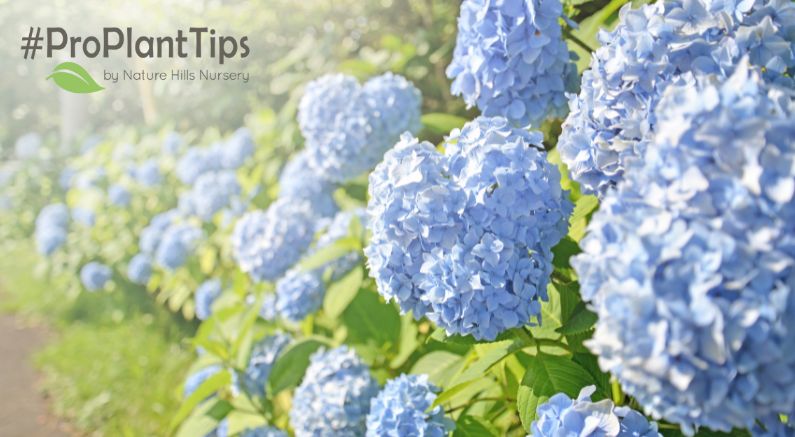Let’s look at a couple different kinds of Hydrangeas, how to best care for them, and what to expect from each.
Hydrangea macrophylla types are a part sun loving group that appreciates some relief from the hot afternoon sun especially in warmer climates. The Hydrangea frenzy started with this group and has grown to include many selections too. This group that Nature Hills currently have up for sale include: Endless summer, Big Daddy, Twist and Shout, Blushing Bride, Let’s Dance Moonlight, Cityline Rio, Cityline Vienna, Next Generation Pistachio, Nikko Blue, Grateful Red, Cherry Explosion, Endless Summer Bloomstruck, Edgy Hearts, Tilt-A-Swirl, Nantucket Blue, Cityline Mars, Tiny Tuff Stuff, Cityline Paris, Everlasting Revolution, Wedding Gown, Let's Dance Starlight, Tuff Stuff Mountain, Tuff Stuff Red Mountain, Everlasting Noblesse, Abracadabra, LA Dreamin, Cityline Venice, Everlasting Jade, Everlasting Garnet, Everlasting Ocean, Abracadabra Star, Everlasting Harmony, and Miss Saori.
This group of Hydrangeas are a bit more tender with hardiness most zones 5 and higher, and a few that are crown hardy in zone 4. In the colder zones they will die back in winter unlike the paniculata types. They love the east side of a house and a nice, evenly moist soil with lots of organic matter and mulch on top of the soil. This whole group can have the flower color changed by growing the plants in a more acidic soil (with a lower soil pH). Pink flowered ones turn blue and the redder ones turn purple. They can have wildly varying colors (even on the same plant exhibiting blues and pinks and everything in between even on the same flower head!) depending upon the soil pH which will vary be site to site and state to state. Aluminum Sulfate or Soil Sulphur can lower the soil pH for this group of Hydrangeas and Azaleas, Rhododendrons, Blueberries and any other plants that might be showing signs of iron chlorosis.
Typically, you would wait to trim this group of plants in spring when they start to grow so you know what is alive and what is not. In the warmer states, the stems that bloomed last year should be cut down to the ground and the ones without flowers allowed to remain and they will flower first. Morning sun, even moisture, and 2-3” of mulch along with a lower soil pH is best for this group.
Hydrangea arborescens group is super hardy and carefree. Most of you know the Annabelle Hydrangea which remains one of the hardiest and so very popular in the group today.
Of the plants that Nature Hills offers in this group includes: Annabelle, Invincibelle Spirit and all the Invincibelle Spirit series, Incrediball, Smooth or Snowhill (H. arborescens ‘Grandiflora’), Ryan Gainey, Invincibelle Wee White, Invincibelle Ruby, Samantha, Incrediball Blush, and Invincibelle Limetta. This group of Hydrangeas basically all re-grow from the ground up each spring. Every spring, trim each stem down to an inch or two before they start to grow. This group is zone 4 and some zone 3 hardy (and warmer) and represent a super carefree type of Hydrangea for sure. This group used to all only be white in color, but more recently there has been introduced some arborescens types that include pink colors too.
There is no changing the color of this group no matter what the soil pH is. The white flowered selections first open white, and then fade to a sage green color, and eventually the flower heads turn brown as they dry and remain on the plants. The pink flowered selections used to be quite light pink but more pink color has been bred into the newest ones. These flowers open pink and fade to a pink and eventually they too will turn brown and remain on the plant.
Some of the newest selections can re-bloom sending up new flowers as the season progresses making them great for cutting. Hydrangea arborescens can be grown in full sun if watered, and part shade and sometimes we have seen them growing in lots of shade. These Hydrangeas will appreciate a couple of inches of shredded mulch over the roots, but not up against the stems. Hardy, sun and shade, and carefree.

